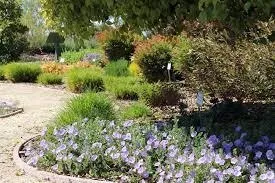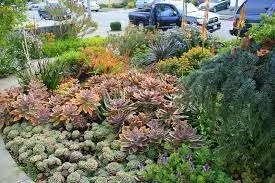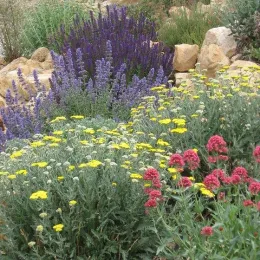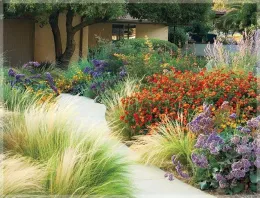Drought Tolerant vs. Drought Resistant Gardens
Drought Tolerant Vs. Drought Resistant Gardens by Flo Pucci Master Gardener.


As a new homeowner in San Joaquin County and a recent graduate of the Master Gardener program, I am interested in ideas that can help me design a garden with low water requirements and low maintenance plants. However, I am constantly mystified about the large array of terms to define: "drought-tolerant," "drought resistance," "drought-adapted," "water-wise," "xeric," "native," "Mediterranean," "environmentally friendly," and “sustainable” gardens. I'm even more perplexed when professionals and retailers use terms conflictingly, even differing on what the terms mean, resulting in time and money wasted. So, I decided to unpack the meanings, techniques, and definitions behind these terms and plant materials that can aid in the pursuit of a drought-resistant garden.
Drought-tolerant. What does drought tolerance mean in connection to the land and the environment? The word "drought" means a period of prolonged exceeding aridity, mainly one that causes extensive crop damage or prevents their successful growth. Once this occurrence is understood, we know that drought causes plants, crops, and wildlife to become parched and eventually die through lack of rainfall and water. Consequently, drought-tolerant and drought-resistance terms are often used synonymously and inaccurately so. In a general sense, the word tolerant means the capacity to withstand pain or hardship and, more specifically, "the relative power of an organism to grow or thrive when subjected to a harsh environmental dynamic."

Drought-resistant. These plants can survive for long periods without water. In other words, they take drought-tolerant one step further. Plants with relatively low water requirements or plants well adapted to an arid climate are described as drought-resistant or drought-tolerant.
Water-wise. This refers to landscaping or gardening with plants that grow well in a garden that manages water efficiently. On the other hand, low water plants are those that are adapted to live through times of water scarcity without drastically changing their attractiveness. They are very resourceful at using water, avoiding heat, keeping cool, and some continue to bloom during the heat and drier time of the year. Examples of water-wise plants: Aloes, African daisies, Pink rockrose, Rosy buckwheat, Gazanias, Madrones, etc.
Xeriscape. This is another term for drought resistance or drought-tolerant landscapes or gardens. This label outlines a landscaping style that uses drought-tolerant plants to help conserve water.
According to UC Master Gardeners, the longstanding concept of xeriscaping as a garden packed with succulents and gravel has changed to low-water-lush. Lush means growing actively with rich foliage, productive, fertile, thriving, and possibly on low water cycles. A good illustration of this concept is the learning Landscape at the Robert J. Cabral Agricultural Center in Stockton.

Indeed, experts warn not to confuse California natives with naturalized plants brought here from other places by human migration and that have established themselves in their new environment like the California pepper tree, originally for South America. Some small sub-groups of these naturalized plants are considered invasive, like pampas grass, vinca, and Mexican feather grass, altering the ecosystem where there are planted. Native plants are often dormant, induced by heat and lack of moisture in the soil. Here, fire season is pervasive during the summer and fall due to the lack of rainfall which is a natural occurrence in the California landscape. Fires regenerate the vegetation growth and maintain the health and vitality of native plants communities. Coastal regions' landscapes are the exception due to coastal fog.
However, for California gardens, one needs to look for plants drought-adapted to our climate, which means plants evolve in sync with our climate's characteristic pattern of cool, wet winters and warm, dry summers. In other words, they tolerate our six months of summer dry season once established. Examples of California native plants: California fuchsia, yarrow, poppy, matilija, manzanitas, toyon, Indian mallow, lupine, and artemisia, just to mention a few.
Established vs. Non-established. This distinction is often overlooked by new gardeners to a significant detriment. An established plant has grown its root system from its former bound root nursery pot life into our garden's soil. However, most plants need to acclimate and develop a new root system to survive without additional supplemental water. As a result, new gardeners going by the label drought-tolerant may think that after the plant is in the ground, it will grow without any additional care. However, plants need a slow transition to maturity once they are in the ground. Planting during the cooler months will help conserve water, and rainfall will keep the plant hydrated. Roots must stay moist and must not be allowed to dry out for two to three months.

Mediterranean. When referring to Mediterranean plants, this classification denotes regions globally that share similar climate characteristics of dry and hot summer and cold and rainy winters. These locations are California, Central Chile, the Mediterranean Basin, the Cape regions of South Africa, and Southwestern and South Australia.
Mediterranean plants primarily consist of arboreal and shrubby evergreen sclerophyllous plants, characterized by complex, leathery evergreens foliage, specifically adapted to prevent moisture loss and oils to evaporate with adaptation to high levels of aridity.
According to some experts, the phrase "summer-dry" is more inclusive because it names the five regions with similar climate characteristics instead of the Mediterranean. Therefore, plants from any sub-tropical region that share similar climate conditions can grow and thrive in California, particularly in the Central Valley. Examples include olive, pistachio, myrtle, juniper, citrus, hydrangeas, bougainvillea, clematis, aromatics, lavender, rosemary, and yarrow.
Drought is a fact of life in the western states. That is why water conservation should be a lifestyle priority in these regions. While local native plants are best suited to most sites, other good choices include drought-resistant plants from different parts of the world. Many of these plants share characteristics that help them survive intense heat and low rainfall periods. Furthermore, plants with low water requirements not only beautify the landscape once established, but also offer many other benefits. Woody perennial herbs such as rosemary, sage, and thyme, all from the Mediterranean region, can be used in cooking and combine well with blooming perennials such as blue-flowering catmint.
In brief, here are some basic guidelines for a practical and drought-resistant garden.
1) Improve your soil by incorporating organic matter.
2) Plant in the right place; group plants with similar water, sun, and shade exposure needs.
3) Reduce the lawn amount around the yard. It requires too much water to stay green.
4) Control weeds.
5) Upgrade irrigation systems by connecting smart controllers to a weather station or drip emitter.
6) Water deeply but infrequently to encourage roots to grow downwards.
7) Mulch to conserve soil moisture.
Water-wise gardens take a bit more to plan than a typical garden, but over time, they look beautiful and offer significant savings in labor cost and, above all, water.
For more information, please check the following sites.
https://sjmastergardeners.ucanr.edu/Water_Conservation_/Low_water_landscapes_/
https://sonomamg.ucanr.edu/projects/Water-wise_Gardening/
https://sjmastergardeners.ucanr.edu/Gardening_with_CA_Natives/
https://cagardenweb.ucanr.edu/Drought_/Drought_Gardening_Tips_/
https://mgsantaclara.ucanr.edu/garden-help/succulents-care/
https://ucanr.edu/sites/sacmg/files/183230.pdf
https://sjmastergardeners.ucanr.edu/Water_Conservation_/Irrigation_/
